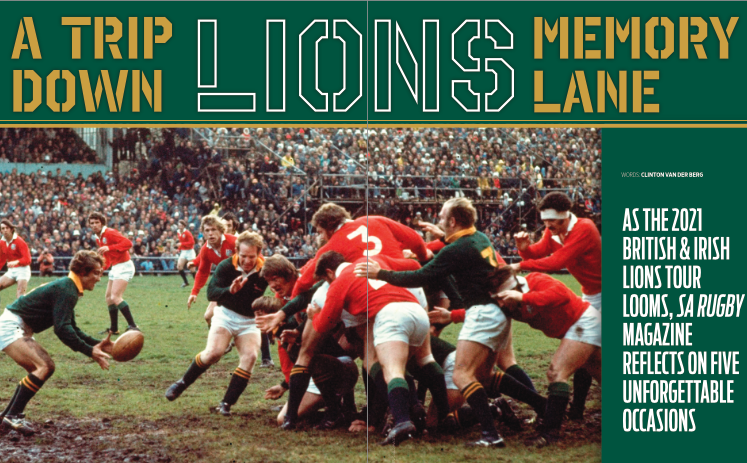As the 2021 British & Irish Lions tour looms, SA Rugby magazine reflects on five unforgettable occasions.
READ: What’s in our latest issue?
VAN DER SCHYFF’S IRREDEEMABLE SADNESS
6 August 1955; First Test, Ellis Park
The Lions tour of South Africa in 1955 produced one of the most exciting matches in the team’s history. It also gave us the crushing image of Jack van der Schyff, in one of the greatest of all rugby photographs.
The Lions arrived to destroy the aura of the Springboks, seeking to play with wit and adventure. A record crowd estimated at between 90 000 and 105 000 flooded Ellis Park.
Van der Schyff, the crocodile hunter who had played all four Tests against the 1949 All Blacks, was chosen out of nowhere as fullback. Fortunes swung and the Boks fought back from 23-11 down to 23-22 to the Lions with barely seconds remaining.
The conversion for the final try was not difficult; the tension was palpable.
As Van der Schyff readied himself, he turned to his captain, Stephen Fry. ‘Don’t you want this one?’ he asked. ‘No, it’s all right, Jack, you’ve been kicking superbly.’
Van der Schyff then turned hopefully to Johan Claassen, who could also kick. Claassen merely grinned.
What happened next is best described by the late Paul Irwin, the Rand Daily Mail sports editor: ‘The match-winning attempt was one he would convert 99 out of 100 times in an ordinary game. But this was no ordinary game. As little scrumhalf Tommy Gentles went down to hold the ball for a place kick, the only sound heard was a distant train whistle.
Van der Schyff took two long strides back, sighted the target and then, like a golfing ‘rabbit’, lifted his head as he went forward to swing his right foot. That lifted head cost the South Africans a 59-year-old record of victory in the first Test of any home series. The ball was hooked two yards wide of the far post.’
Van der Schyff was devastated, Ivor Hanes’ famous photograph capturing the precise moment when his body deflates.
He never played for South Africa again.
FLYING FRIK
8 June 1968; First Test, Loftus Versfeld
The 1968 Lions arrived in South Africa in bullish mood. They appeared powerful and capable, represented by titans like Barry John, Willie John McBride, Gareth Edwards and Gerald Davies.
The Boks themselves drew together a powerful unit that included players such as Jan Ellis, Piet Greyling, Jannie Engelbrecht and Frik du Preez, all meneers of the game. The Lions kept the score respectable (they lost 25-20) but were overwhelmed.
One of South Africa’s three tries came from Du Preez, and the majesty of his score is revealed in grainy black and white film footage. So powerful, so heroically defiant is Du Preez’s rampage that now, more than 50 years later, it remains among the most vivid ever.
Darting around the front of the lineout from his position in the heart of the contest, he took the pass near the touchline. Thundering for the line with the ball tucked under his left arm from 40m out, the footage shows his hair billowing in the wind as his legs carry him closer to the line.
As reporter AC Parker wrote, Lions’ fullback Tom Kiernan might as well have tried to stop a locomotive going at full steam. The Lions could do nothing and Du Preez dived in for the most celebrated of scores, electrifying the 75 000-strong crowd.
Years later, he would be named South African Player of the Century.
THE WAR OF ’74
13 July 1974; Third Test, Boet Erasmus Stadium
Before the 1974 Lions shipped out, captain Willie John McBride gathered his players at the Britannia hotel in London. ‘Take no prisoners,’ he ordered.
It was to become the theme of one of the most celebrated tours of all time, arguably the Lions’ greatest. McBride and coach Syd Millar decided to attack the Springboks where they were strongest: among the forwards. From this philosophy was born the ‘99 call’, a rallying cry in the event of one of the Lions being targeted.
‘We knew what was coming and we were ready,’ says McBride, who had experienced South African intimidation tactics on the Lions tours of 1962 and 1968.
The Boks were belted in the first two Tests. Facing a series loss, they turned to Moaner van Heerden for inspiration. He was big and mean. There were 11 changes in all, including the bonkers selection of No 8 Gerrie Sonnekus at scrumhalf. The Lions went to the Kruger Park. They took two planes: one loaded with players, the other with beer.
The third Test was one of the most ferocious in history: the original Battle of Boet Erasmus. Just before halftime, Van Heerden laid into Bobby Windsor. This was the cue for mayhem. JPR Williams ran 40 metres to unleash a volley of punches at Van Heerden while there were sporadic outbreaks elsewhere, with McBride prominent.
Surprisingly, some rugby was played and the Lions eased home 26-9. Years later, rugby-playing politician Bantu Holomisa remarked on how the Lions had more than just subdued the Boks. ‘We had a slave mentality then. We were taught that everything the Afrikaner did was perfect. but here was a team putting them in their place, humiliating them.’
GUSCOTT’S GLORY
28 June 1997; Second Test, King’s Park
The world champion Springboks had just come off an away-series win against France and were confident they had the beating of the Lions. The Lions themselves were unburdened by expectation.
‘The Lions look like pussycats,’ declared a headline in the Cape Argus after the tourists’ first match.
So much for that. They rocked the Springboks in the opening Test in Cape Town 25-16. In Durban, reality bit harder as the Springboks fell victim to Jeremy Guscott’s wondrous drop goal in the dying minutes.
With the Springboks seemingly assured of a draw, the ball popped out of a ruck in the 22m area and Guscott loomed up and launched it perfectly to put the Lions ahead with fewer than four minutes remaining. It was one of just two he would land in a 65-Test career.
The Boks lost 18-15, surely the most dramatic series-decider in Lions history.
Defeat was a bitter, undeserved setback for the Boks. Three tries to none, an assured performance in the set-pieces and a heroic collective display should have won them the match and squared the series. But 18 points were left on the table as each of Henry Honiball, Andre Joubert and Percy Montgomery squandered shots at goal.
Given scraps of possession, the Lions made the most of every opportunity. Scott Gibbs on the charge was a sight for sore eyes, but there he was, smashing Os du Randt to the ground.
Disbelieving South Africans were left reeling. Captain Gary Teichmann was distraught, recalling in his autobiography that it was the most disappointing day of his entire career.
BLOOD and THUNDER
27 June 2009; Second Test, Loftus Versfeld
There have been bigger Test matches. There have been better Test matches. But none were more brutal than the one that unfolded in the second match of the three-Test series in Pretoria in 2009.
The facts alone tell the story: six players ended up in hospital after a riot of gouging, a sin-binning, cunning foul play, violent tackles, serious injuries, uncontested scrums, a controversial decision by the TMO and a last-minute penalty that settled the match and the series.
In his autobiography Bomb, Welsh prop Adam Jones set the scene for the looming war.
‘The South African fans appeared to be waving as our bus approached, but as we got closer, we realised they were all doing the ‘wanker’ sign. If we had been outside, I’m sure they’d have happily ripped our heads off.’
The most graphic of the day’s moments occurred when Schalk Burger gouged the right eye of Lions wing Luke Fitzgerald that saw him binned and subsequently cop an eight-week suspension.
Eccentric Bok coach Peter de Villiers had a typically outlandish take: ‘I don’t think it should have been a card at all. This is sport, this is what it is all about.’
Paradoxically, the ferocity only added to the greatness of the match with both teams determined to bully one another.
Fortunes swung wildly, but the balance shifted when Jaque Fourie held off an attempted tackle to score a wonder try in the corner. Replacement Morné Steyn banged over the conversion to give the Boks the lead for the first time with seven minutes to go.
But the Lions hit back to level 25-25 before Ronan O’Gara, chasing a high ball, was penalised for taking out Fourie du Preez in the air. From 51m out, Steyn produced one of South Africa’s most treasured kicks to avenge the series defeat a dozen years before.
*This feature first appeared in the latest SA Rugby magazine, now on sale!





